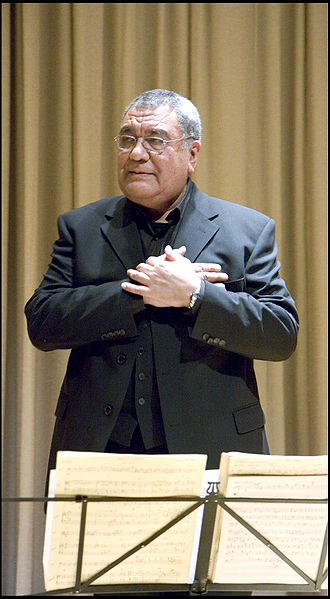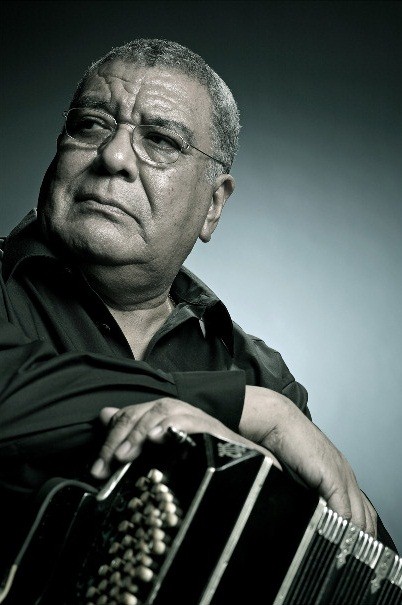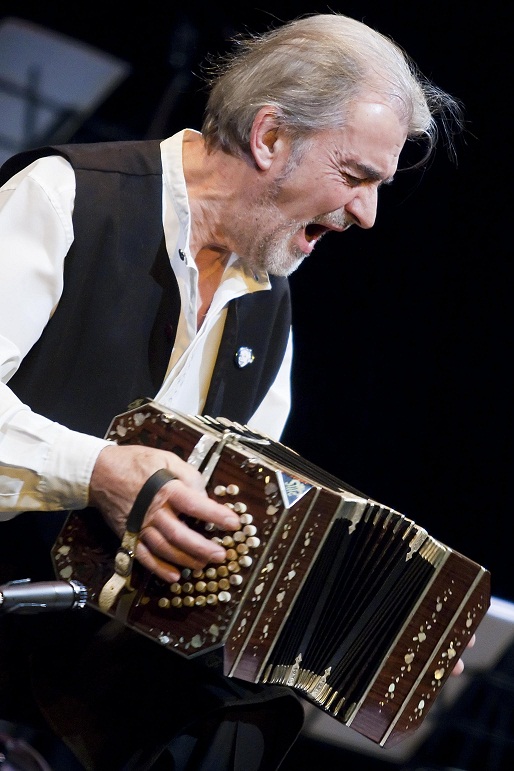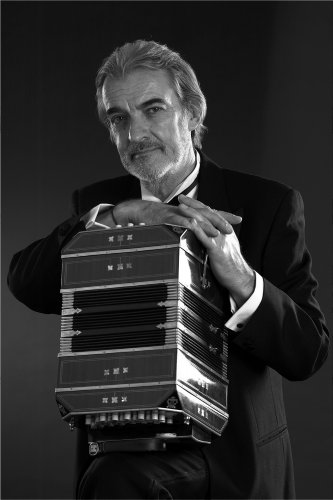<Back to Index>
- Composer and Musician Timoteo "Dino" Saluzzi, 1935
- Composer and Musician Rodolfo Mederos, 1940
PAGE SPONSOR


Timoteo "Dino" Saluzzi (born on May 20, 1935 in Campo Santo (Ingenio San Isidro), Salta Province) was an Argentine musician.
The son of popular carpero composer and instrumentalist Cayetano Saluzzi, Dino played the bandoneón since his childhood. Other than his father, he was influenced by Salta musicians such as Cuchi Leguizamón, and by the lyrical strain of the tango of Francisco de Caro and Agustin Bardi. Dino described the vividness of his musical sketches as "an imaginary return" to the little towns and villages of his childhood.
For much of his youth, Saluzzi lived in Buenos Aires, playing with the Radio El Mundo orchestra. He would play in orchestras for a living, while touring with smaller, sometimes jazz - oriented ensembles, developing a personal style that made him a leading bandoneonist in Argentine folklore and avant garde music (especially since Ástor Piazzolla did not participate in projects other than his own). His recording career did not start until the 70s, along with Gato Barbieri, when he signed a couple of crazy lyricism albums under the name of Gaucho. Over this decade, he worked on many tours in South America and specially in Japan, but always associated to other names, as Mariano Mores or Enrique Mario Franchini.
Through word of mouth publicity (mostly from expatriate musicians) he was invited to several European music festivals, and landed a contract with the ECM label. Several records have resulted, including Kultrum, a 1998 free experimental effort with the Rosamunde Quartet. From the beginning of the 1980s onwards, there were collaborations with European and American jazz musicians including Charlie Haden, Tomasz Stanko, Charlie Mariano, Palle Danielsson, and Al Di Meola.
ECM brought Saluzzi together with Charlie Haden, Palle Mikkelborg and Pierre Favre for Once Upon A Time ... Far Away In The South, and subsequently with Enrico Rava for Volver. Rava had worked extensively in Argentina, and Haden's sympathy for Latin American music was well known; furthermore Palle Mikkelborg and Dino Saluzzi had worked together productively in George Gruntz's band: there was a common ground on which an artistic exchange of ideas could take place. Saluzzi later played with 'Haden's Liberation Music Orchestra', and also toured with the 'Rava Saluzzi Quintet'.
In 1991, Saluzzi recorded an album with his brothers Felix and Celso and his son José María on guitar, kicking off his "family project", which has since toured many countries. Mojotoro drew upon the full range of South American musics: tango, folk, candina music, candombe, the milonga music of the la Pampa province...
Anja Lechner and Dino have toured widely as a duo, too and US jazz magazine "Down Beat" declares the album they recorded together, Ojos Negros album of the year (best of 2007 list).
Dino
Saluzzi symphonic works were presented with Anja Lechner and Metropole
Orkest at Muziekgebouw, Amsterdam, in February, 2009. Soloist: Dino
Saluzzi - bandoneon; Guest: Anja Lechner - cello; Conductor: Jules
Buckley.


Rodolfo Mederos (born March 25, 1940) is an Argentine bandoneonist, composer and arranger. He lived in Cuba and France; in Argentina, he founded the cult group Generación Cero.
As a young man he was captivated by fellow bandoneonist Ástor Piazzolla. However, he tried to transcend that influence as he strove for more. Even though he had played with Piazzolla for several years, he joined the Osvaldo Pugliese Orchestra, alongside other young musicians of his generation who shared similar musical ideas.
This porteño, born in the neighborhood of Constitución, whose childhood was spent in the province of Entre Ríos, later went to the University of Córdoba to study biology. He is an outstanding bandoneon player, considered today to be among the world's best.
After 1960 he put together his early groups to play at provincial radio stations and on television. His Octeto Guardia Nueva had such an impact that Astor Piazzolla, when he heard it during one of his tours, suggested that he travel to Buenos Aires.
When a few years later Piazzolla returned to Córdoba, he invited Mederos to appear in his recitals.
In 1965 Mederos traveled to Buenos Aires and cut his first record "Buenos Aires, al rojo" in which he played Cobián's and Piazzolla's pieces as well as his own compositions.
After
spending two years abroad, first in Cuba and later in Paris, he
returned to Argentina, and in 1969 he joined the new Osvaldo Pugliese
orchestra, which was formed due to the decision of its former players
who wanted to play only with the ensemble, Sexteto Tango, they had
recently put together. He was in the bandoneon section with Arturo
Penón, Daniel Binelli and Juan José Mosalini.
In 1976 he put together a new group, Generación Cero, that attracted a cult following. His appearance with his group was hardly conventional and perhaps irreverent. Its sound tried to achieve a fusion between jazz, rock and the music of Buenos Aires. It displayed far fetched arrangements with impressionist reminiscences. It was an intentional rupture, a juvenile search that looked for a new road in music.
In spite of the fact that a bandoneon was one of the instruments of the group, it did not mean that this rare and experimental music was a variant of the tango genre even though they played a tango tune, because neither the "licks" nor the rhythm belonged to tango, and the arrangements modified the melody to the point of making it hardly recognizable. However, little by little they were reaching an intellectual sector, avid for innovations.
In 1976 the first LP was released, "Fuera de broma 8". It started a series of this never conforming and audacious style. The subsequent albums were: "De todas maneras" (1977), "Todo hoy" (1978), "Buenas noches, Paula" (1983), "Verdades y mentiras" (1984) and "Reencuentros" (1989).
Despite
their features, these works reached a widespread recognition, and
Mederos' artistic personality was growing and achieving public acclaim, especially abroad.
Mederos began the 1990s with a solid position in the musical scene. He returned to the recording studios with a new series of CDs, in different settings: "Tanguazo" (1993), "Carlos Gardel" (1994), Mi Buenos Aires querido" with a trio that spotlighted the great pianist Daniel Barenboim (1995), "El día que Maradona conoció a Gardel" (1996), "El tanguero" (1998) and "Eterno Buenos Aires" (1999). In 2000 he continued his output with the record "Tango Mederos - Brizuela" and with another disc that included the soundtrack of the film "Las veredas de Saturno" that he had composed twenty years before.
In 1999 Mederos formed a quintet with the pianist Hernán Posetti, the violinist Damián Bolotín, the guitarist Armando de la Vega and the double - bassist Sergio Rivas. They recorded the above - mentioned disc "Eterno Buenos Aires".
Besides the soundtrack of the French - Argentine motion picture directed by Hugo Santiago (1986), Mederos composed the soundtracks, or part of them, of: Sergio Renán's "Crecer de golpe" (1976), Simón Feldman's "Memorias y Olvidos" (1987), Tristan Bauer's "Después de la tormenta" (1991), Jana Bokova's "Diario para un cuento" (1997), Jaime Chávarri's "Sus ojos se cerraron" (1998) and Bebé Kamin's "Contraluz" (2001).
Mederos' special ability to blend different rhythms and genres with an air of tango can be evidenced by the series of recitals in which he has appeared, invited by folk, pop and rock musicians. Other highlights include his collaborations in recordings with Mercedes Sosa and Luis Alberto Spinetta, and recently with the Catalonian Joan Manuel Serrat in his disc titled "Cansiones." Mederos had played with the latter in 1994 in two numbers on the disc "Nadie es perfecto."
«Somewhere art must irritate and arouse suspicions. Art is authentic when it is not complacent.» «There is a kind of piazzollization that is smothering. His pieces (Piazzolla's) produce light, but they can dazzle.»